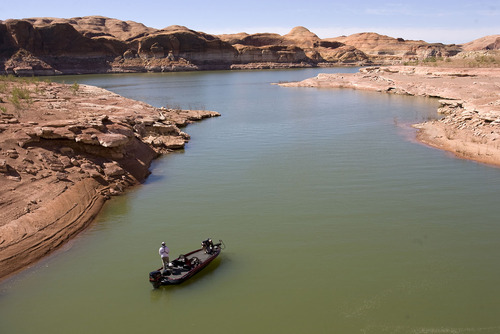This is an archived article that was published on sltrib.com in 2012, and information in the article may be outdated. It is provided only for personal research purposes and may not be reprinted.
Striped bass from the southern reaches of Lake Powell, along with largemouth bass in Quail Creek Reservoir, have joined the list of Utah fish with mercury consumption advisories.
Bringing the statewide tally to 21 locations statewide, the advisories cover stripers caught south of Dangling Rope Marina in Lake Powell and all of Quail Creek Reservoir in Washington County.
"We thought it was time to get the message out to people," Amy Dickey of the Utah Division of Water Quality told the Statewide Mercury Work Group on Thursday, noting that methylmercury levels in Lake Powell's stripers have hovered around the worrisome zone for several years.
With this first mercury warning for Lake Powell, one of the state's most popular recreation spots, officials suggest pregnant women and children under 6 should eat no more than one 4-ounce serving per month.
Women of childbearing age and children from 6 to 16 should limit consumption to two 8-ounce servings per month, and others should have no more than eight, 8-ounce meals in a month. The Utah offices overseeing health, wildlife and water quality issued the advisories, and the sister agencies in Arizona joined the new warning for Lake Powell.
Mercury pollution is normally linked to coal-fired power plants but emissions from China and gold plants in Nevada are also suspected in Utah's problem.
Also on Thursday, Utah adjusted its system for determining safe levels of mercury-contaminated fish. The changes bring Utah's advisory categories more in line with those in Arizona, Idaho, Nevada and California, said Craig J. Dietrich, a toxicologist with the Utah Department of Health.
"We are being as protective as we can be with sensitive groups," he said, "while promoting the consumption of seafood in the diet. It's healthy to eat fish."
Methylmercury is a neurotoxin that builds up in the food chain. Too much of it affects development and motor skills, especially in growing babies, children and the unborn. Meanwhile, the omega-3 fatty acids in fish are considered beneficial for cognitive and heart health.
Paul Dremann, chair of the Utah Anglers Coalition and a member of the state's mercury-study panel, said he doubted the new advisories would have much impact on the sport.
"It basically means you have to take care and pay attention to the advisories," he said, noting that fishing is a $800 million annual business in the state that has not been affected noticeably by past consumption limits.
The state has been collecting mercury data for about seven years, ever since learning that the Great Salt Lake had the highest levels of toxic methylmercury contamination in the United States. In addition to the fish advisories, the state has consumption advisories for three species of ducks hunted on the Great Salt Lake.
And, after testing 308 fish from Lake Powell, regulators found mercury levels that are too high in southern parts of the lake, but not in northern areas.
Roger Wilson, who oversees the aquatics section of the state Division of Wildlife Resources, noted the state was previously "erring on the side of caution" but now has dramatically increased the safe-consumption allowances for most people.
"We're not saying: don't eat these fish," he said. "We're saying: eat according to the guidelines that have been issued" and that are kept up-to-date on the state's mercury web page.
He added that his office promotes catching stripers on Lake Powell to help manage their populations.
"We want to encourage fishing and [people] taking fish home and eating it."
Twitter: @judyfutah —
Mercury contamination Recreation not affected
State regulators point out contamination does not pose health risks for most recreation — including catch-and-release fishing, swimming, boating and waterskiing — in the lakes, reservoirs, streams, rivers and creeks with advisories.
Meanwhile, 322 water bodies in Utah, including 200 rivers and streams, plus 122 lakes and reservoirs, have been tested for mercury. Elevated methylmercury has been found in 21 of those sites.



